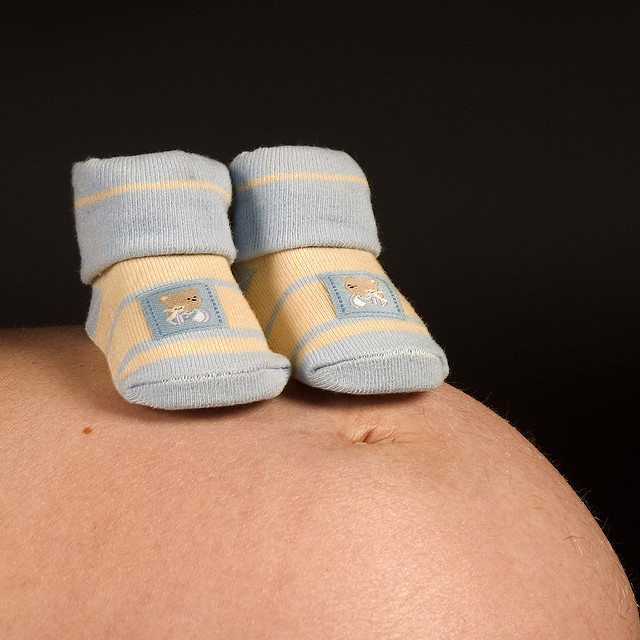Surgical stitch can affect babies
Interview with
 Every year around two million pregnant women worldwide undergo a simple procedure known as cervical cerclage - putting a stitch in the cervix, or neck of the womb, which helps to prevent premature birth or miscarriage. While it's broadly very safe and helps to save babies' lives, Phillip Bennett and his team at Imperial College London have identified an important issue with the type of thread used for this important bit of medical sewing. Kat Arney went to see him...
Every year around two million pregnant women worldwide undergo a simple procedure known as cervical cerclage - putting a stitch in the cervix, or neck of the womb, which helps to prevent premature birth or miscarriage. While it's broadly very safe and helps to save babies' lives, Phillip Bennett and his team at Imperial College London have identified an important issue with the type of thread used for this important bit of medical sewing. Kat Arney went to see him...
Phillip - About 80% of doctors in the United Kingdom use a braided tape-like stitch material. It's flat, it's quite fat, it looks a little bit like a shoelace, and that is thought to be good because it's strong, it's easy to tie knots in and it's not likely to damage the cervix.
About 20% of doctors use a nylon thread which looks more like a fishing line, if you like, and there have been concerns that that nylon thread is not so easy to tie and also that it might potentially damage the neck of the womb.
We have a particular interest in the role that the bacteria in the vagina play in pre-term birth. And, some time ago, we asked the question - does a cervical stitch change the bacteria that are in the vagina?
Kat - So what are the different risks of these two different sorts of procedures for making these changes in the bacteria?
Phillip - So, what we found is that first of all, all of the women in whom we put a cervical stitch already started with slightly abnormal bacteria in their vagina, which points towards the idea that one of the risk factors for delivery early is having abnormal bacteria.
What we found then is that in the women who had the tape-like -the braided tape-like - stitch, the healthy bacteria tended to die off and they tended to be replaced with more harmful, more pathogenic bacteria. And that was associated with increased inflammation in the vagina and cervix, and with evidence on ultrasound that the cervix was beginning to ripen and soften. Whereas the people whose cervical stitch was performed using the nylon stitch, we found no changes at all. It had no effect on the bacteria, it didn't cause inflammation, and it had no effect on the structure of the cervix.
Kat - How did you find this out? How many women did you look at?
Phillip - So, in that part of the study, we just looked at 25 women who'd had the stick with the braided stitch and 25 women who'd had the stitch with the nylon stitch, and then we looked in the laboratory at what happened to the bacteria and to markers of inflammation. But what we then did was we went back to look historically at our hospital data. When we looked back at nearly 700 patients across five university hospitals in London, Birmingham and Cambridge, we found that those women who had had the nylon stitch had a lower risk of preterm birth, and a lower risk of their baby dying in-uterus than with women whose stitch had been performed using the braided material.
Kat - Presumably this procedure is carried out in many countries around the world - how would that scale up?
Phillip - We estimate that are about 2 million cervical cerclage operations performed annually throughout the world. So we think that if everybody in the world changed from the tape to the nylon, then this would save 170,000 babies per year from dying, and it would prevent 170,000 pre-term births.
Kat - In terms of the absolute risk, obviously some women might be very concerned - can we put this in perspective?
Phillip - Well, the great majority of cervical cerclage operations, over many decades, have been performed using the tape stitch and it's clear that, in the right patients, putting a cervical stitch in is definitely beneficial. So what we've effectively shown here is an operation, which was a safe operation, which improves outcome, can be made even safer if we choose the right suture material.
It's also important to bear in mind that the data we have at the moment is retrospective - it's from looking back at case series. And we really need to get the result of a prospective study in which the only differences between the two groups of patients are the type of stitch material that we're using; and that trial is currently being conducted by the University of Birmingham.
So what I would say is, if anybody is about to have a cervical cerclage procedure, please talk to your doctor and I would encourage you to take part in that study. For people who are not in the study, I think that we could say, at the present time, it's probably better that the nylon stitch be used rather than the tape stitch.










Comments
Add a comment